In 1960, John Conrad of Sacramento, California, built an 8′ Paddle Wheel Boat from plans published in Mechanix Illustrated. The boat was described as “a barrel of fun for the kids and you can build it for less than $35.” He built it for his grandchildren, and they used it for many years on lakes and rivers around the Sacramento area. One of those grandchildren, Davi Rodrigues, who has just turned 70, held on to the memories of that boat and all the outings he and his siblings, cousins, and friends enjoyed in it, and “always missed it.”
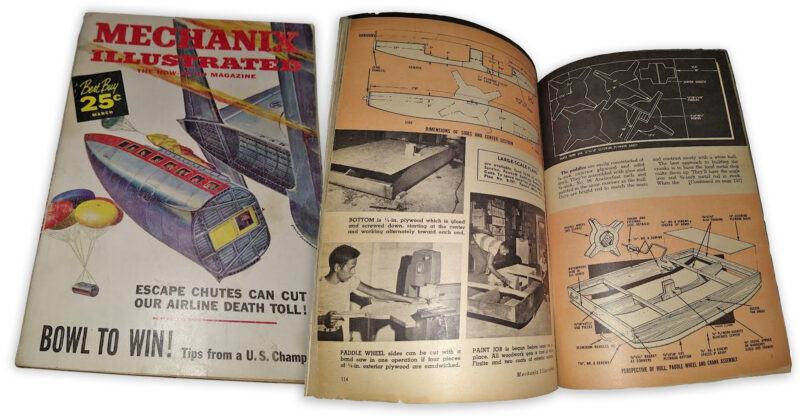
The magazine that started it all: Davi’s grandfather, John Conrad, used this March 1960 issue of Mechanix Illustrated to build the family’s original Paddle Wheel Boat. Six decades later, Davi referred to the same magazine when he built his updated version, GUAM ROSE.
John Conrad died in 2002 at the age of 100. “My siblings and I owed him and my grandmother a lot. They were very stable, and full of old-world knowledge, which they taught us. I traveled a lot with them, hunting, fishing, and foraging in several western states, British Columbia, the Yukon, and Alaska. I learned woodworking from him, and other crafting from her.” Among his grandfather’s belongings Davi found the original plans for the Paddle Wheel Boat. “They were drawn up by Hal Kelly, who has several old boat plans floating around the internet, but the paddle-wheeler isn’t among them, so I’m happy my grandfather kept a lot of things.” Davi held on to the plans and 20 years later decided to build his own paddle-wheel boat.
Davi is not a boatbuilder, but he is a woodworker and a maker. “I’m always building things. The past few years it’s been sheds—three for us and one for each of our two kids. I also built a lot of planters. I try to use space carefully, so some of the planters are built up off the ground and we use the space below to store firewood. One planter is 8′ high built on top of a compost bin. Water from the planter drains down to keep the compost moist.” He also mills much of his own wood and stores planks for later use. Recently he built a solar kiln to speed up the wood seasoning.
 Photographs by Davi Rodrigues
Photographs by Davi RodriguesThe two side panels and the center frame have the same dimensions and bottom curve. Davi was able to clamp them together and plane all three at the same time.
For Davi, the paddle-wheel boat was a straightforward project. It is, essentially, a shallow rectangular box with a rockered bottom, a center longitudinal frame that adds strength and supports the crankshaft for the wheels, and two seat platforms, one at either end. “It’s 8′ long by 4′ wide, and I built it of okoume plywood on pine.” The hull is 11 1⁄2″ deep amidship, decreasing to 7″ in the ends. The original plans called for the side panels and framing to be of 3⁄4″ cedar, spruce, or mahogany, and the bottom panel to be a single 8′ × 4′ sheet of 1⁄4″ exterior plywood. “I used 3⁄8″ exterior plywood salvaged from an old walk-in box refrigerator for the paddle-wheel faces, and the seat platforms where I also added two low-cost stadium seats. For the side panels, frames, and paddle scoops I used 15⁄16″ yellow pine that I’d milled from a tree that was felled in front of a neighbor’s property, and for the paddle-wheel center gussets that house the crankshaft, I used some oak that I’d milled from a tree that came down in a recent windstorm on another neighbor’s property. I did buy a single sheet of ¼″ okoume plywood for the bottom…it was one of the few things in the project that I bought new.”
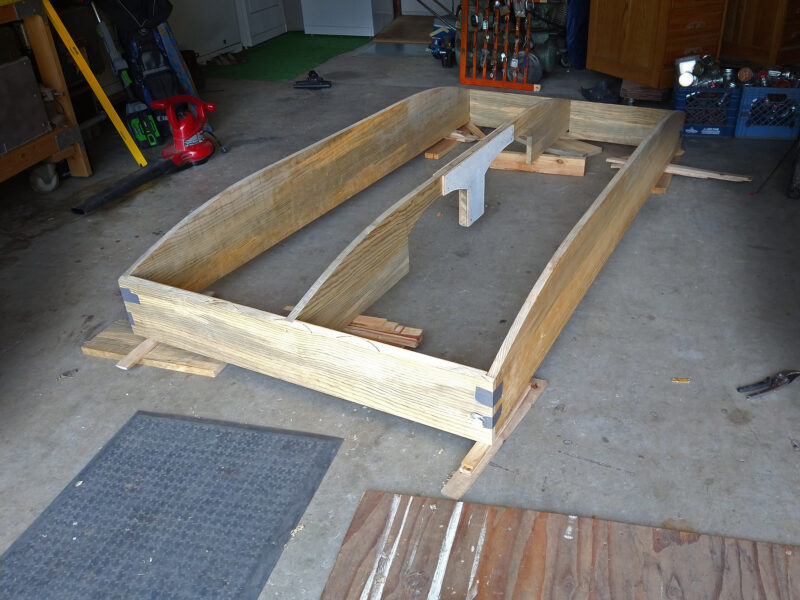
The sides and ends come together in right-angled joints, which Davi epoxied and through-fasted with marine-grade bronze screws.
The connection with Davi’s grandfather didn’t stop with the plans. “I used several tools that my grandfather had used when he built the first one: his old router, his tablesaw dado stack, his antique hand planes, and his ancient stick welder. I also used my own Shopsmith, which is an extremely versatile piece of equipment, especially if you’re strapped for space. Reviewing the pictures in Mechanix Illustrated, it looks like that’s what was used in Hal Kelly’s shop when he wrote the article.”
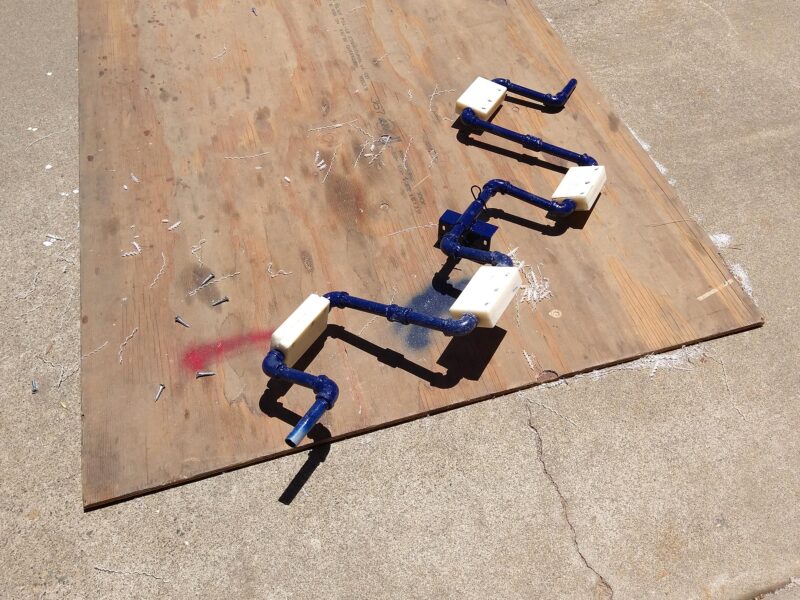
Davi fashioned the cranks from ½” black iron pipe, threaded together and welded at the joints. He cut the pedals from some scrap polypropylene cutting board, drilled through to accept the crankshaft, and then drilled grease holes so that he can keep the pedals well-lubricated and rotating smoothly.
Davi didn’t exactly replicate his grandfather’s boat. The original version, as designed by Kelly, included hand-cranked paddles—ideal for accommodating crew of varying ages and sizes—but Davi decided he wanted pedaled propulsion. “I’m much older now, and appreciate the upright, slightly reclined, position for leisurely cruising as opposed to being bent over for the trip.” He built the crankshafts of 1⁄2″ black-iron pipe assembled with 1⁄2″ elbow joints welded at the threads. Through the wheel hubs and center gussets he fit 3⁄4″ pipe into which the 1⁄2″ crankshaft would slide, to be held in place by a keeper pin. “I wanted the wheels to be easily removed and installed—you don’t want to be fidgeting with hardware while you’re standing on rocks or in mud surrounded by other boaters wanting access to the ramp.” However, the external and internal diameters of the two pipes didn’t quite fit, and he had to sand the interior face of the larger pipe to get them to slide into one another. He fashioned the foot pedals out of “some scrap white polypropylene cutting board material with tiny holes drilled through for applying grease, and some scrap angle iron for the crank’s mounting hardware.”
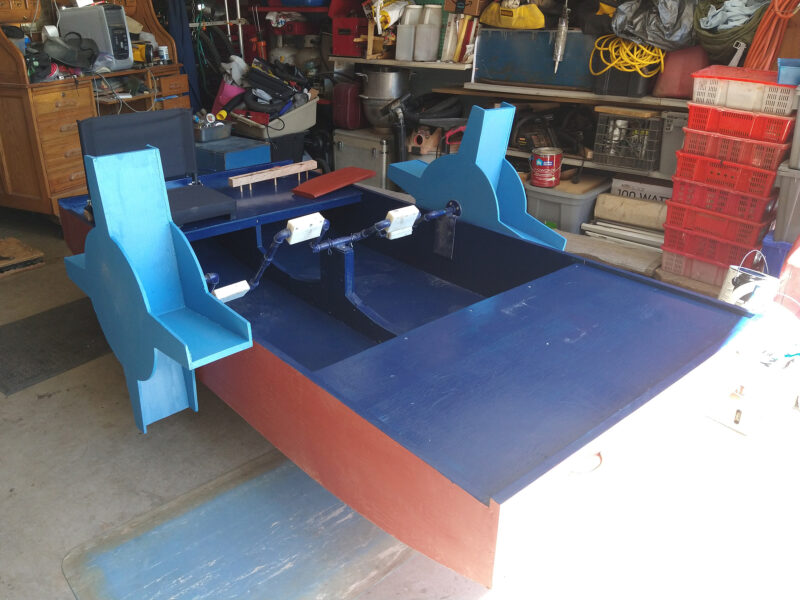
Having changed the propulsion system from hand to pedal cranks, Davi also added some inexpensive stadium seats for the operators.
Finally, he fashioned a simple helm, using more 1⁄2″ pipe for the tiller and scrap pine and metal for the rudder. “The paddle cranks can work together or independently (by removing the keeper pin that connects them) so you can steer by pedaling both wheels separately, but if there’s only one person aboard, you can work with one wheel and the rudder.”
Davi applied two coats of epoxy to the hull, and after construction was completed, he finished everything with two coats of marine topside paint.
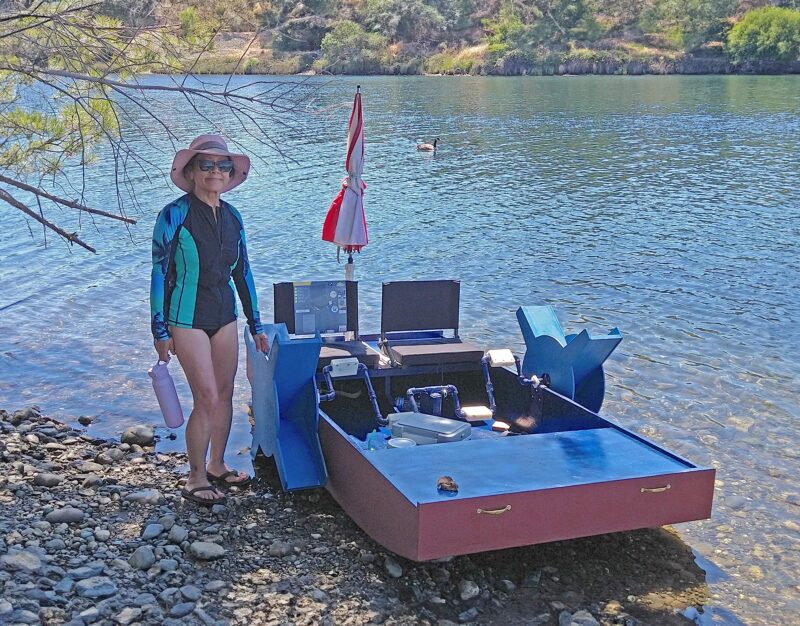
The carrying handles—two on each end—are featured in the original design and greatly assist when moving the boat around on land. For transporting the boat in his pickup, Davi takes the paddle wheels off by removing the locking pins that hold them in place on the crankshaft.
The build took Davi a while, but only because, he says, “I worked on it sporadically, as time permitted. Sometimes it would go fast, other times I just did a little cutting and stopped.” But by the end of June 2024, the boat was ready to go. Davi had decided on the name, GUAM ROSE. “My wife, Elaine, is Chamorro, a native of the Northern Marianas Islands, in particular Guam. She’s tolerated my boat habits since we met in 1984. I remember her tucked below in the cabin of our 18′ sailboat with our firstborn son, then aged two, pounding to weather in a blow in Tomales Bay. GUAM ROSE (I got the name from the rice Elaine likes) seemed to fit the current need for a relaxing boat outing in comfort. She likes it.”
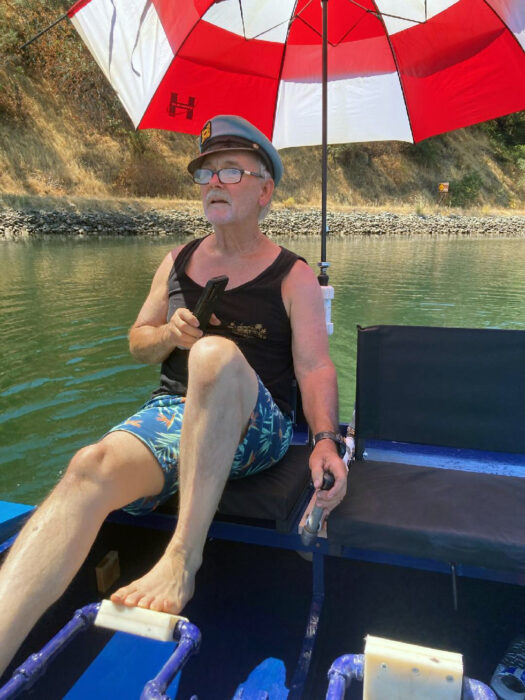 Elaine Rodrigues
Elaine RodriguesFor a touch of glamor and to provide some shade for the pedalers, Davi—seen here sporting his grandfather’s cap—installed a flagpole holder for an umbrella. He also made a rudder out of some scrap pine, and a simple tiller out of ½” black iron pipe.
Together, Davi and Elaine took GUAM ROSE to Lake Natoma, east of Sacramento, for the grand launching. “We chose it because there’s a 5-mph speed limit so it’s quiet. We loaded the boat into the back of the pickup [Davi estimates the boat weighs around 100 lbs or less and that the paddles, which are disconnected for transportation, add another 20 lbs], and offloaded it with no fuss. We were underway in minutes and were soon paddling effortlessly across the lake. The alteration from hand to foot propulsion did change the weight distribution slightly as you have a tendency to lean back when pedaling, but I’m in the process of making new seats, which will help with that.”
On their first outing, Davi and Elaine sat back and enjoyed the ride. “Many people took an interest, asked questions, gave compliments, and we even had a lot of thumbs-up from passers-by in kayaks or on paddleboards.” And Davi brought his grandfather’s memory along with them: “I wore his ancient captain’s cap, as he always did when he was piloting his boats.”![]()
Jenny Bennett is editor of Small Boats.
Do you have a boat with an interesting story? Please email us. We’d like to hear about it and share it with other Small Boats readers.
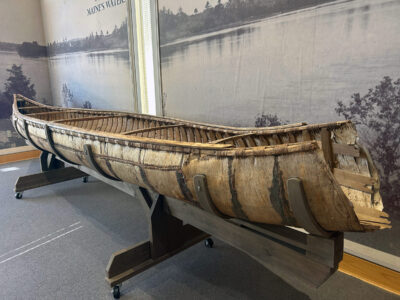
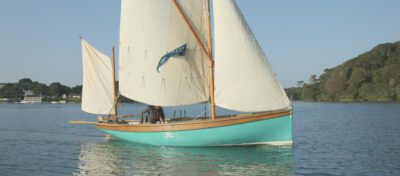
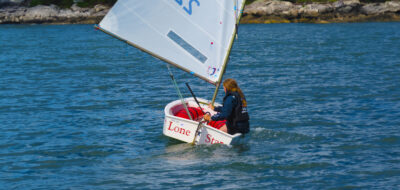
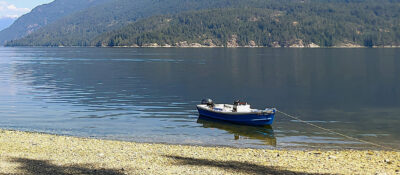
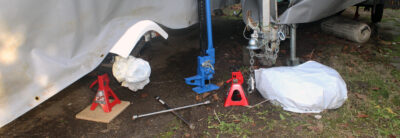
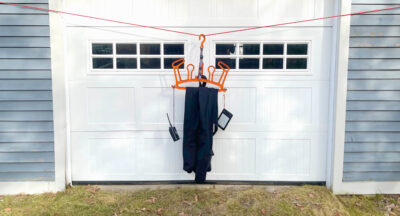
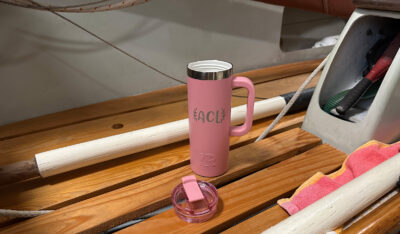
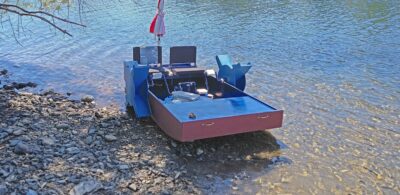
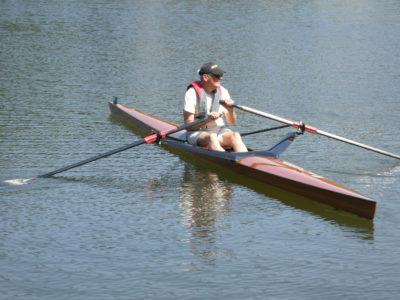
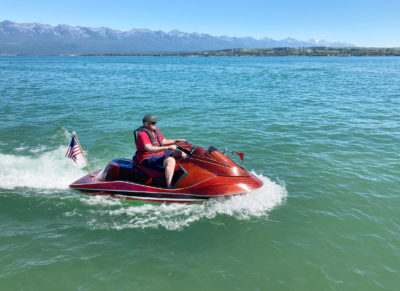
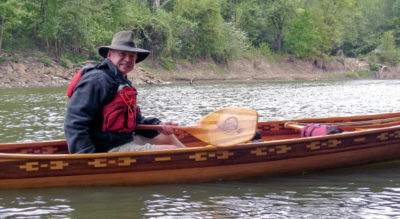
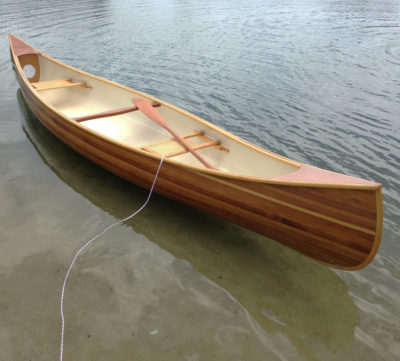
Outstanding box boat! My first boat was a PuddleDuck Racer. BTW, Dave Gerr’s “The Nature of Boats” has a boat inspired by the same ideas in one of the chapters.